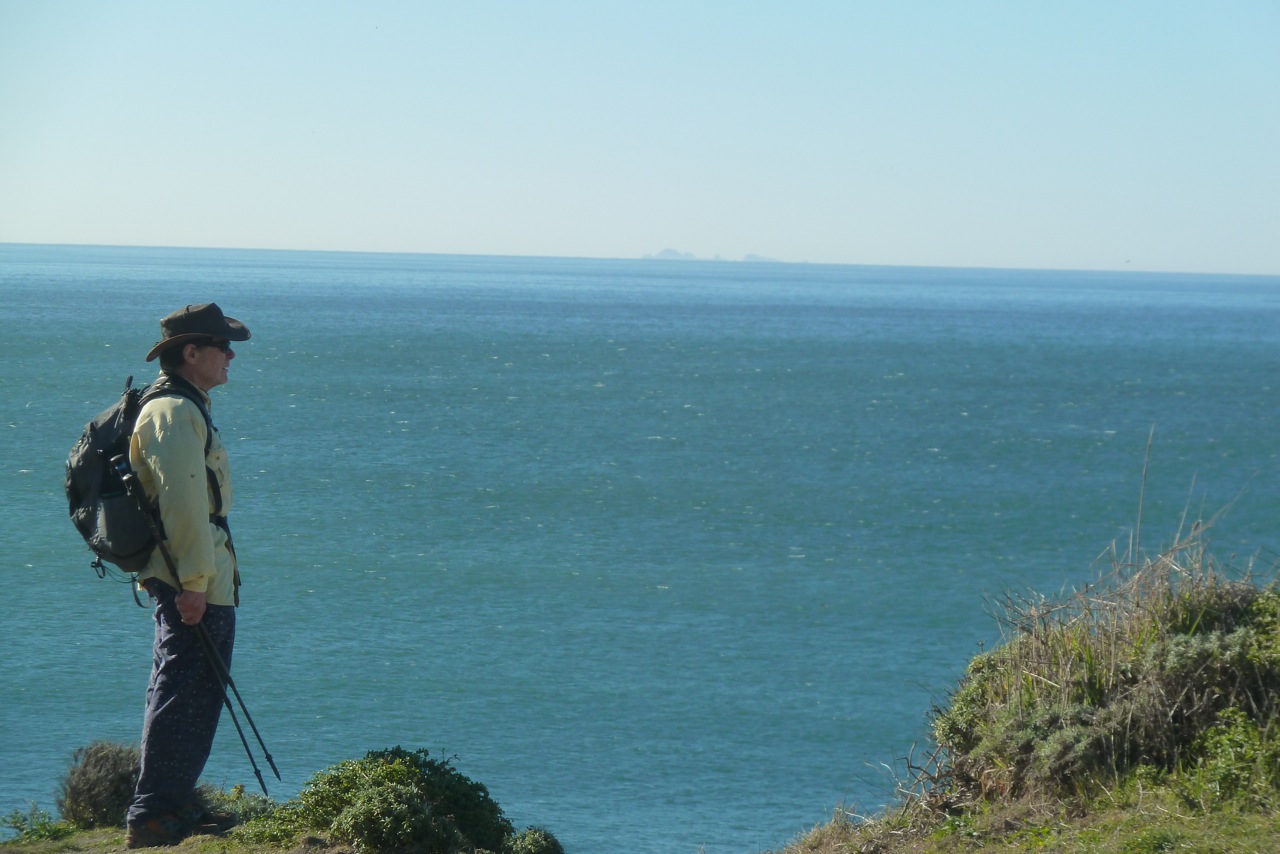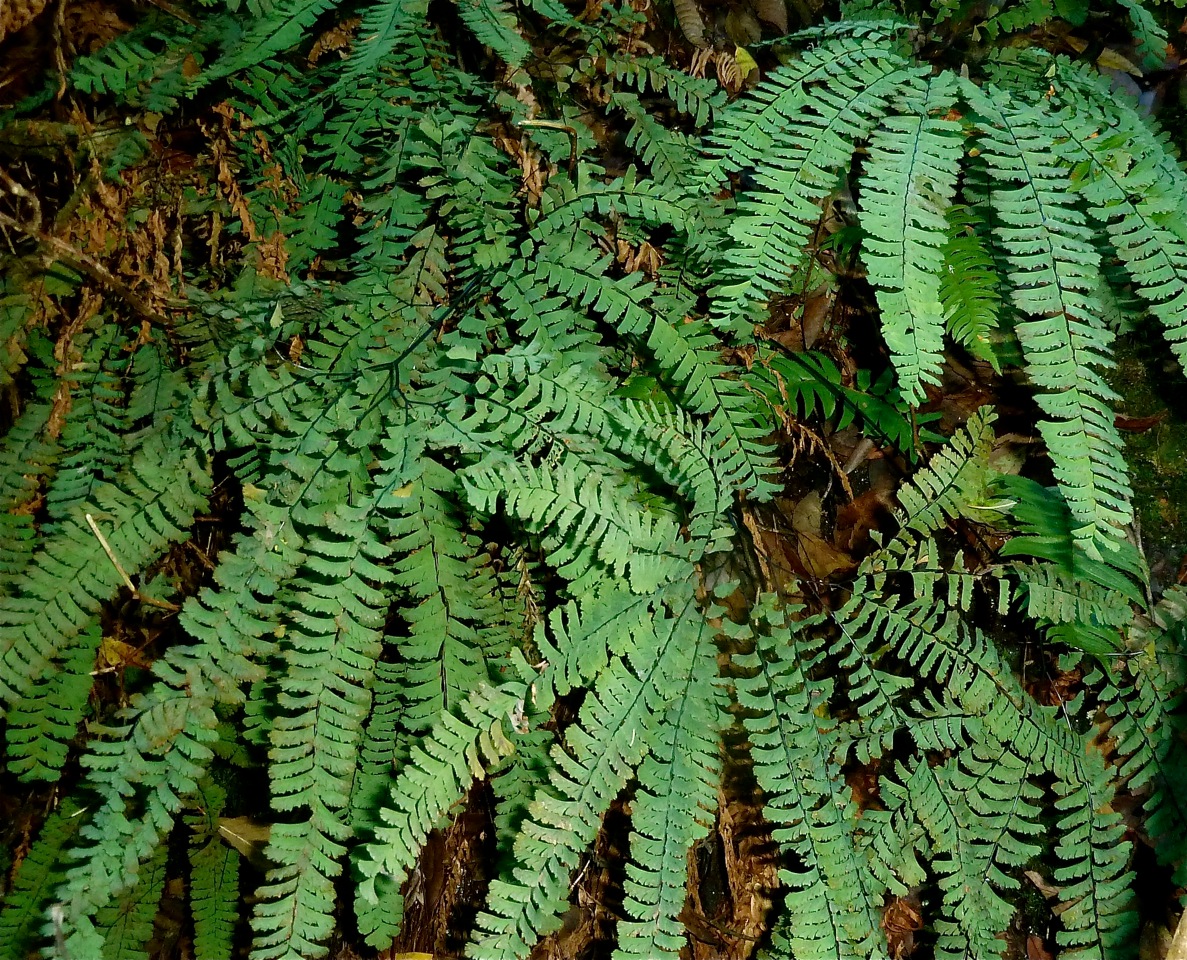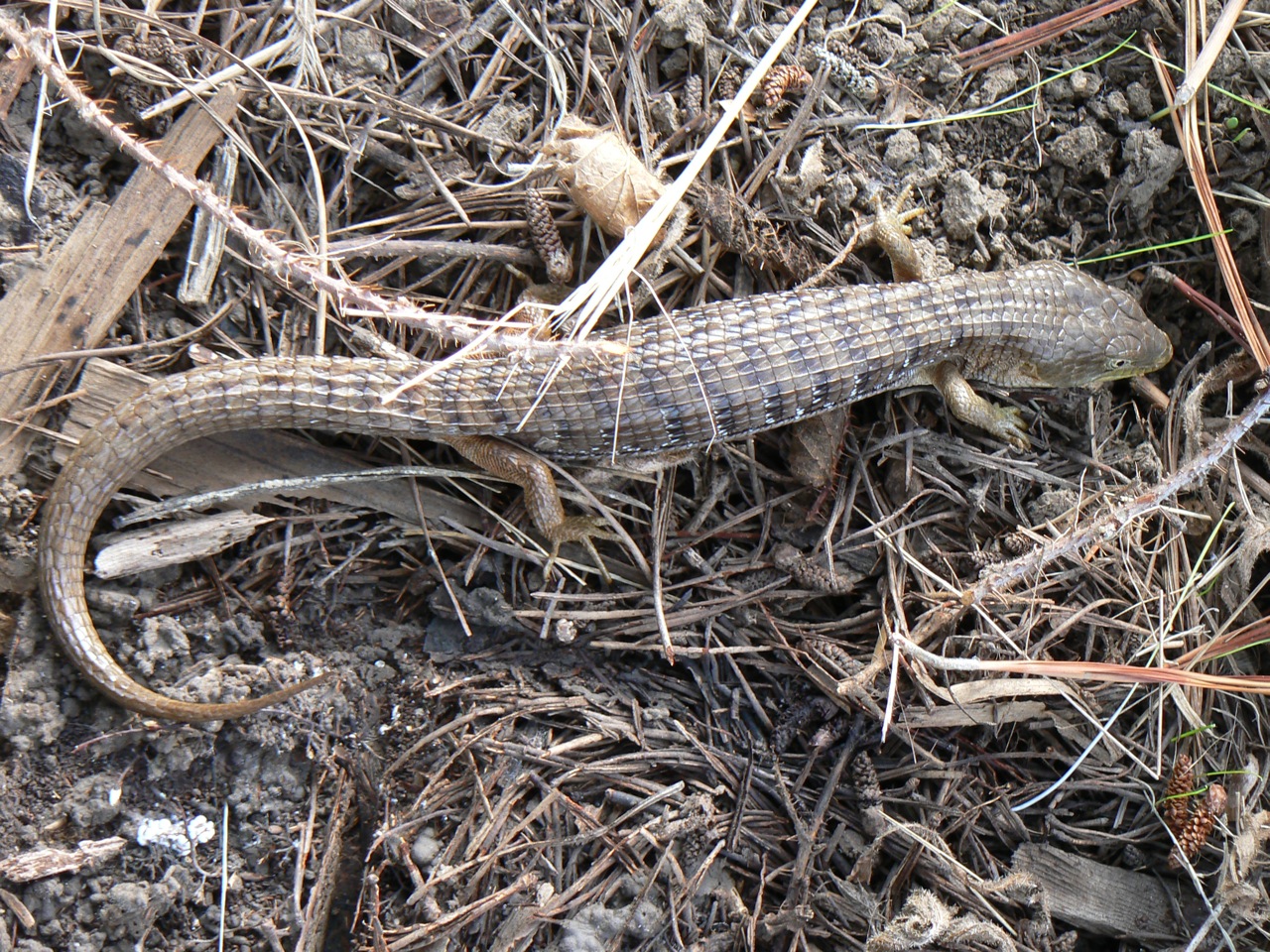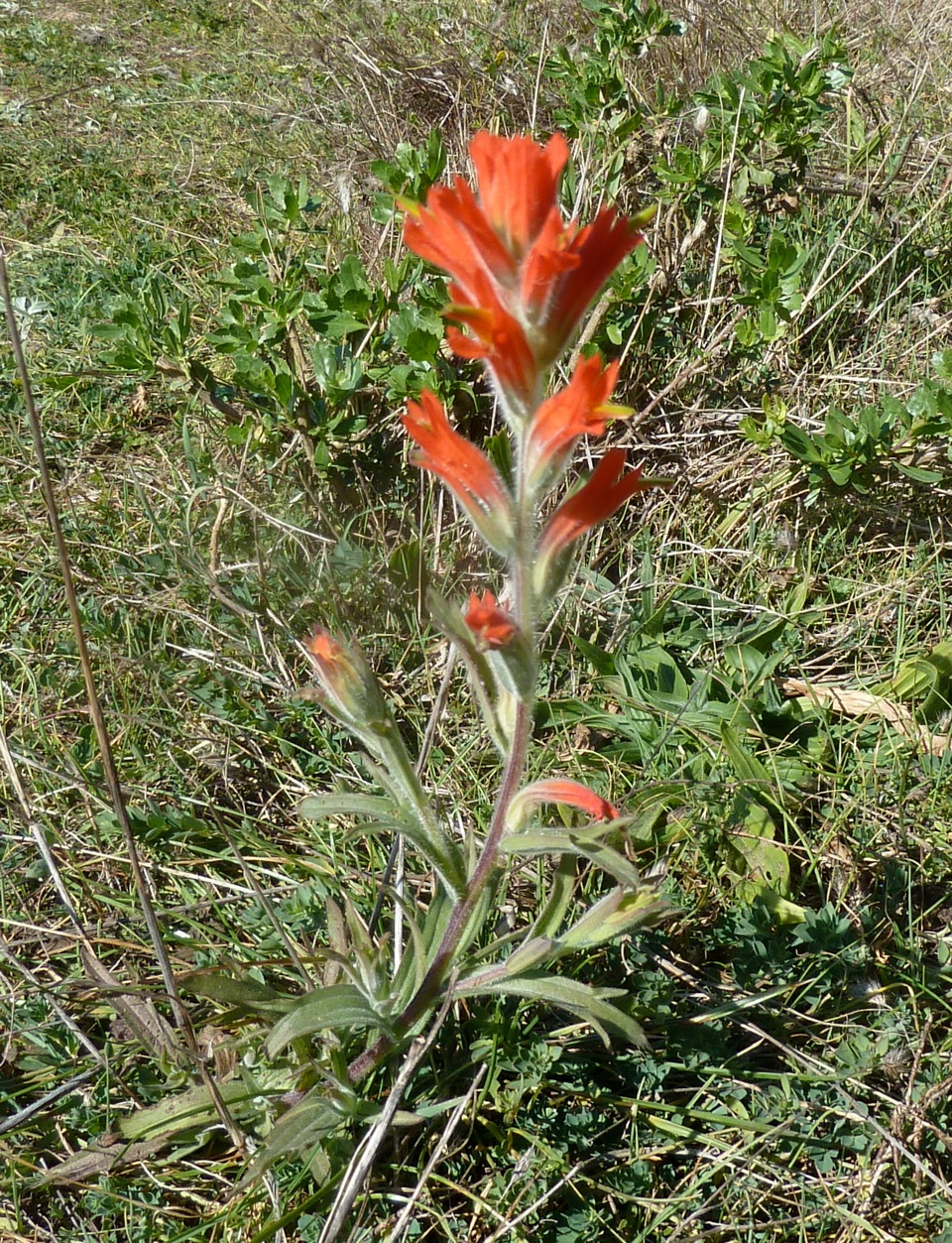Hike date: January 13, 2012.
Trail: Bear Valley-Meadow Trail Loop (including the Arch Rock spur and sections of the Coast Sky, and Meadow trails): 10.2 miles with friend, Terry Nordbye.
Conditions: sky crystal clear, wind negligible, temperature 43-66°F.
Map of route
The Bear Valley trail, heading southwest from Park Headquarters to the coast, is one of the emblematic walks, and the most traveled trail, on the Point Reyes Peninsula. The trail transects the peninsula, near its center, through a break in the spine of Inverness Ridge. The first mile and a half is a fire road through Douglas fir forest, following the course of Bear Valley Creek, with a flourishing understory of ferns. Where small rivulets join the creek (still flowing even in this driest January in years), maidenhair ferns (Adiantum) line the banks. These are the most delicate representatives of their tribe, with feathery fronds and hair-thin black stems. These stems were prized as design elements in Native American basketry.
In the spring, these ferny glens are alive with the songs of winter wrens, but now, in mid-winter, we hear only their call notes, an emphatic double chip. Early flowering milkmaids–snow-white, dime-size flowers, aka cardamine or bitterroot–are already blooming along the trail’s edge. About halfway to the coast, the trail daylights from the forest shadows at Divide Meadow, so named because the stream courses divide here, with Bear Valley Creek flowing north into Tomales Bay and Coast Creek flowing to the Pacific.
The Bear Valley Country Club–a rural retreat for wealthy San Franciscans who visited to hunt, fish, and trapshoot–occupied the meadow from 1890 to 1940s. The club was a luxury that did not long survive the Depression, and was abandoned two decades before the park was established. Even earlier, one can imagine the site occupied by grazing elk and grizzly bear, for which the valley was named. The large mammals are no longer here, but black-tailed deer are common, and many of the park’s mountain lion sightings are from the meadow. (A friend who runs here often swears she can smell lion scent along this section of the trail.)
A few hundred yards beyond the meadow a rather large bobcat (probably a male), short tail erect, crosses the trail. This stunning cat has a characteristic gait; its rather long hind legs lift the rear-end higher than the shoulders, a rakish profile. The cat disappears silently into the forest before we can raise our binoculars or cameras. The bobcat, perhaps our most beautiful mammal, is rather common here and much less secretive than the much larger mountain lion. We agree: any “bobcat day” is a good day.
Preeminent old-school naturalists Joe Grinnell, Joe Dixon, and Jean Lindsdale, who wrote Fur-bearing Mammals of California (1937), called bobcats “wildcats” and wrote: “It is quite certain that wildcats are bolder than mountain lions. Wildcats are often observed at close range, whereas lions are almost never seen, even by persons who spend much time within the animal’s range.” Now that hunting and trapping these cats is an anachronism from an earlier age of predator persecution, I suppose the only local predator of the bobcat is the mountain lion. However, that aforementioned book on fur-bearing mammals recounts the finding of “the mummified bodies of a bobcat and a great-horned owl locked in a death grip.” (Speaking of which: Sometimes bobcats climb trees, and when sitting on a high limb, with their buffy patterning and ear tufts, at first glance resemble a great-horned owl.)
As we continue along the trail and approach the coast, the forest begins to thin slightly; moss-covered buckeye trees and red alders–both leafless in winter–trace Coast Creek westward. In the distance, a large fir snag with an osprey nest comes into view, silhouetted against a cerulean blue California sky. As we approach the junction with the Coast Trail, the forest gives way to coastal scrub and the air is redolent with that honey-sweet smell of coyote bush. The forest’s edge, this ecotone, seems more alive than the deeper, shadier forest. A Hutton’s vireo is calling from the sunlit firs, a Townsend’s warbler chips, and we hear a wrentit’s song, that syncopated, descending whistle.(Give it a listen here.)
Coastal scrub is also called “soft chaparral” and the wrentit, known as “the voice of the chaparral,” is typical of this habitat. It is an odd bird, the only North American member of its family, and the only local songbird that reliably sings year-round.

-
Terry Nordbye at Arch Rock Overlook, with view over calm seas to the Farallon Islands. Photo by Jules Evens.
Soon we take the short spur that leads to Arch Rock overlook. It is a lucid morning; no clouds, translucent blue sky, and the Farallon Islands, usually obscured by fog, are clearly visible far offshore. Even the Pacific is living up to its name; calm, gentle swells, no breakers or white water in sight.
Atop Arch Rock, we take a break for a cup of pu’er, a fermented tea from China, and some snacks. As soon as we settle on the rocks, a small flock of Nuttall’s white-crowned sparrows surrounds us, waiting for our crumbs to drop. Like the wrentit, this common local bird is resident here, but it is confined to the fog belt along the immediate coast where it remains year-round. This “fog sparrow” is named after the British naturalist Thomas Nuttall (1786-1859), author of the first field guide to North American birds.
Nuttall’s sparrows are so sedentary, so attached to the area of their birth, that the several distinct subpopulations (“demes”) on the Point Reyes Peninsula have evolved unique song dialects. There are six different song dialects on the peninsula and the birds at Arch Rock belong to a deme that extends from Limantour south to Double Point, it’s song distinguished from its neighbors by the “buzzy” quality of its final notes.
Here’s a song that was actually recorded on the Estero Trail, of a bird within the “Limantour” song group, and differs slightly from the “buzzy” variety at Arch Rock, but only in the last few notes. Just as we were about to leave Arch Rock and continue our trek, the sparrow pictured above burst forth with its clarion song. Mid-January and already these birds are singing!
On Coast Trail to Sky Trail leg, through coastal scrub, an alligator lizard scurries across the trail; again, another sign of spring in mid-winter.
Here, the Coast Trail parallels the shoreline for a short distance (0.5 mi) before intersecting Sky Trail. We turn onto Sky Trail and follow the gentle switchbacks uphill. On this dry south-facing slope, California sagebrush (Artemisia californica) joins the coyote bush. We rub the aromatic leaves, redolent of the Sonoran desert or the Mexican plateau. Terry says that different sages have characteristic smells; to my somewhat smell-challenged nose, all merge into a pleasant potpourris. Farther along, a few flowers are already blooming; a splash of vermilion signals a cluster of Indian paintbrush. (It’s only January!)
Some large scat decorates the trail where a narrow game path intersects the Coast Trail. Cigar-sized (T. holds it up and imitates Groucho Marx), a neat package of mammals hair and hide, at first we think it may be lion sign. But, it’s twisted and pinched at one end (cat scat tends to have blunt ends), characteristics clearly showing it was dropped by a passing coyote.
An uphill mile or two of gentle switchbacks leads through an ecotone of coastal scrub being slowly replaced by Douglas-fir, the consequence of fire suppression over the past fifty or so years. When we stop for lunch and more tea beneath a candelabra bay, the breeze through the needles of firs has a specific sound, but we wonder momentarily if it might be the distant sea . . . then realize there were no waves, no swells, this calm day.
Farther along the trail are some familiar flowers blooming, small, sky blue with white centers, but neither of us can remember the flower’s name. Some kind of geranium, a non-native garden escapee we’ve both seen every year for decades. I know I know the name, but simply can’t recall, a memory lapse that seems to be becoming increasingly common of late. When I get home I describe them to my wife, Meryl, and within a spit second she says, “Forget-me-nots.” True story.
The last few miles through the fir forest to the Meadow Trail and back down to Bear Valley passes some second growth, but also some huge trees that must have escaped the crosscut-saw a century ago and the chainsaw a half-century ago. We pause and lean against some of the larger trees. Though tired from our hike, there is a calm provided by these old sentries that soothes the sinews and the soul.
Walkabout critter list
Reptiles
Alligator Lizard
Insects
Black Ground Beetle
West Coast Lady
Birds
Acorn Woodpecker
American Crow
American Kestrel
American Robin
Anna’s Hummingbird
Band-tailed Pigeon
Bewick’s Wren
Black Phoebe
Brandt’s Cormorant
Brewer’s Blackbird
Brown Creeper
Brown Pelican
Bushtit
California Quail
California Towhee
Cedar Waxwing
Chestnut-backed Chickadee
Common Loon
Common Raven
Dark-eyed Junco
Fox Sparrow
Glaucous-winged Gull
Golden-crowned Kinglet
Golden-crowned Sparrow
Great Blue Heron
Hairy Woodpecker
Hermit Thrush
Horned Grebe
Hutton’s Vireo
Northern Flicker
Pacific Wren
Pelagic Cormorant
Pine Siskin
Pygmy Nuthatch
Red-shouldered Hawk
Red-tailed Hawk
Red-throated Loon
Ruby-crowned Kinglet
Sharp-shinned Hawk
Song Sparrow
Spotted Towhee
Steller’s Jay
Surf Scoter
Townsend’s Warbler
Turkey Vulture
Varied Thrush
Western Bluebird
Western Gull
Western Scrub-Jay
White-crowned Sparrow
Wrentit
Mammals
Bobcat
Brush Rabbit (scat)
Common Raccoon (tracks)
Coyote (scat)
Gray Fox (scat)
Harbor Seal
Horse
Human Being
Mule Deer
Western Gray Squirrel











